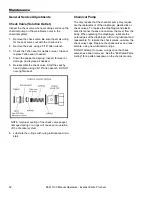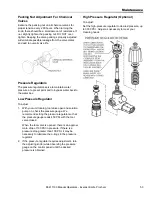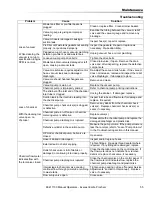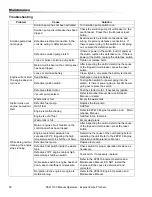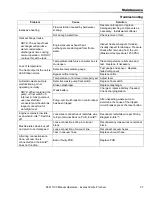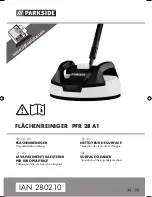
55
Maintenance
Troubleshooting
Problem
Cause
Solution
Loss of vacuum
While cleaning, the
vacuum is not up to
specification. Engine
RPM is normal.
Waste tank filter or pre-filter basket is
plugged.
Clean or replace filter. Clean strainer basket.
Vacuum gauge is giving an improper
reading.
Examine the tubing between the vacuum relief
valve and the vacuum gauge and remove any
blockage.
Vacuum hose(s) damaged, causing a
suction leak.
Inspect hose(s), repair or replace.
Pre-filter or Waste tank gaskets not sealing
properly, not positioned properly.
Inspect the gaskets. Repair or replace as
necessary. Re-position lid(s).
Plugged vacuum hose or vacuum plumbing
between pre-filter box and waste tank.
Unplug vacuum hose or inlet plumbing.
Loose vacuum pump drive belts.
Tighten the drive belts
Waste tank drain valve is damaged or left
open, causing a vacuum leak.
Close drain valve, if open. Remove the drain
valve and, after inspecting, replace the defective
components.
Vacuum relief valve requires adjustment or
has a vacuum leak due to damaged
diaphragm.
Re-adjust the vacuum relief valve. If the vacuum
does not increase, remove and inspect the relief
valve diaphragm. If damaged, replace.
Vacuum exhaust heat exchangers are
plugged.
Remove and clean.
Vacuum pump is worn out.
Replace the vacuum pump.
Loss of chemical
With the cleaning tool
valve open, no
chemical
Chemical pump is improperly primed.
Refer to chemical pump priming instructions.
The strainer at the inlet end of the chemical
inlet tube is clogged.
Unclog the strainer. If damaged, replace.
Suction leak in the inlet tube leading into
the chemical pump.
Inspect inlet tube and flow meter for damage and
replace, if required.
Chemical pump check valve(s) is clogged
or defective.
Remove any debris from the chemical check
valve(s). Replace chemical check valve(s) or
seals, if necessary.
Chemical prime/on-off valve or chemical
metering valve is defective.
Replace valve(s).
Chemical pump diaphragm is ruptured.
Disassemble the chemical pump and replace the
damaged diaphragm and plastic disk.
Defective cylinder in the solution pump.
Measure the pump volume. If the pump volume is
less than normal, refer to "Loss of Pump Volume"
in the Troubleshooting section in this manual.
HP model,
chemical pump, ball valve is
closed.
Open valve.
Hose is kinked or damaged.
Inspect and/or replace hoses
Chemical flow meter
indicates flow with
the tool valve closed
External leak in chemical piping.
Tighten fittings. Re-apply thread sealant where
required. If any fittings are damaged, replace.
Outlet check valve is full of debris or
damaged, not allowing it to close properly.
Close the chemical valve on the control panel. If
the flow meter does not indicate flow, remove
debris or replace check valve, if necessary.
Chemical pump diaphragm is ruptured.
Close the chemical valve on the control panel. If
the flow meter still indicates flow, replace the
chemical pump diaphragm and plastic disk.
Internal leak in chemical valve causing
continual flow through prime tube returning
to waste tank.
Tighten valve packing nut (see "General Service
Adjustments" section in this manual). Replace
valve, if necessary.
Flow setup valve open.
Close valve.
86411100 Manual Operators - Everest E-Idle Prochem












